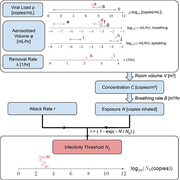
Is a study posted on medRxiv, Prof. Mara Prentiss and two former Harvard physics students, Arthur Chu and Karl Berggren (MIT), analyzed transmission of COVID-19 using five well-documented case studies: a Washington state church choir, a Korean call center, a Korean exercise class, and two different Chinese bus trips. In all cases the likely index patients were pre-symptomatic or mildly symptomatic, which is when infective patients are most likely to interact with large groups of people. An estimate of N0, the characteristic number of COVID-19 virions needed to induce infection in each case, was calculated using a simple physical model of airborne transmission. The researchers found that the N0 values are similar for five COVID-19 superspreading cases (~300-2,000 viral copies) and of the same order as influenza A. These results suggest that viral loads relevant to infection from presymptomatic or mildly symptomatic individuals may fall into a narrow range, and that exceptionally high viral loads are not required to induce a superspreading event. Rather, t he accumulation of infective aerosols exhaled by a typical pre-symptomatic or mildly symptomatic patient in a confined, crowdedspace (amplified by poor ventilation, particularly activity like exercise or singing, or lack of masks) for exposure times as short as one hour are sufficient. The authors calculate that talking and breathing release ~460N0 and ~10N0 (quanta)/hour, respectively, providing a basis to estimate the risks of everyday activities. They also provide a calculation which motivates the observation that fomites appear to account for a small percentage of total COVID-19 infection events.
Read Mara Prentiss, Arthur Chu, Karl K. Berggren, "Superspreading Events Without Superspreaders: Using High Attack Rate Events to Estimate N0 for Airborne Transmission of COVID-19," medRxiv 2020.10.21.20216895; doi.org/10.1101/2020.10.21.20216895.
